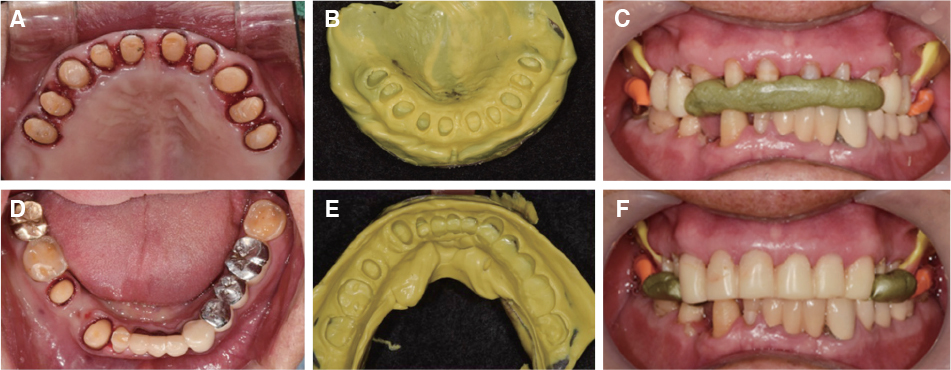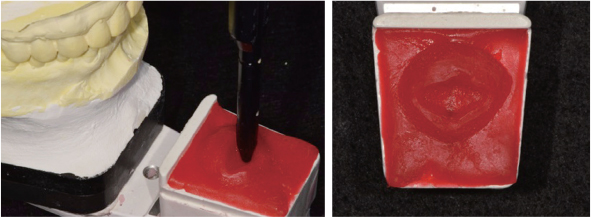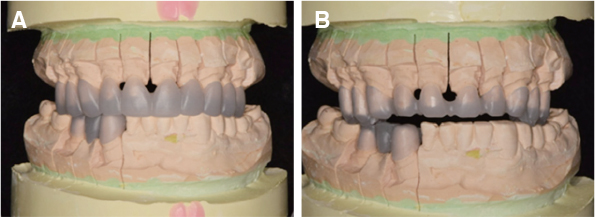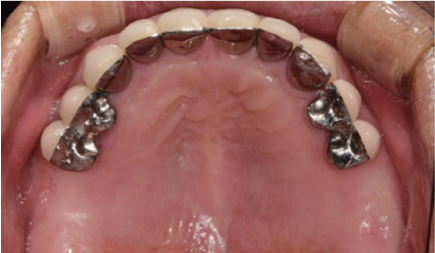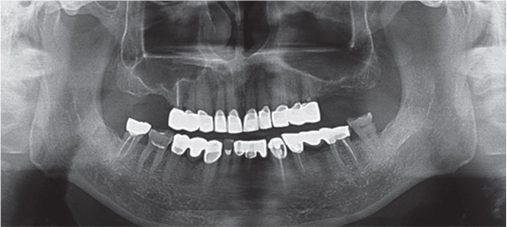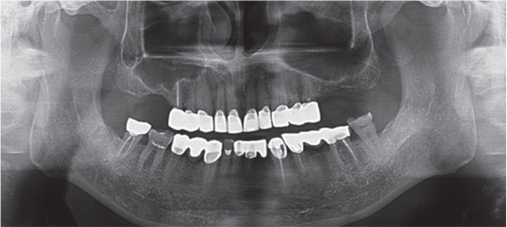J Korean Acad Prosthodont.
2018 Oct;56(4):347-353. 10.4047/jkap.2018.56.4.347.
Full mouth rehabilitation using removable partial denture in patient with loss of vertical dimension due to worn dentition
- Affiliations
-
- 1Department of Prosthodontic Dentistry, Veterans Health Service Medical Center, Seoul, Republic of Korea. jkkang76@hanmail.net
- KMID: 2424036
- DOI: http://doi.org/10.4047/jkap.2018.56.4.347
Abstract
- Gradual attrition is a normal process of aging, but severe attrition causes occlusal disharmony, functional disorder and esthetic problems. The collapse of posterior support may cause attrition of anterior teeth, and loss of occlusal vertical dimension (OVD). And it induces the pathologic change of the TMJ, unaesthetic facial appearance and decreased masticatory function. In this case, 70 year-old male presented with decreased vertical dimension and esthetic problems due to worn dentition. Based on assessment of intraoral findings, diagnostic cast and radiographic examination, full-mouth rehabilitation with increase of OVD was planned. After 10 month follow-up, occlusal stability is maintained and through this procedure, satisfactory outcomes were achieved in esthetic and functional aspects.
MeSH Terms
Figure
Reference
-
1. Ibbetson RJ, Setchell DJ. Treatment of the worn dentition: 2. Dent Update. 1989; 16:300–302. 305–307.2. Hemmings KW, Howlett JA, Woodley NJ, Griffiths BM. Partial dentures for patients with advanced tooth wear. Dent Update. 1995; 22:52–59.3. Turner KA, Missirlian DM. Restoration of the extremely worn dentition. J Prosthet Dent. 1984; 52:467–474.
Article4. Briggs P, Bishop K. Fixed prostheses in the treatment of tooth wear. Eur J Prosthodont Restor Dent. 1997; 5:175–180.5. Willis FM. Features of the face involved in full denture prosthesis. Dental Cosmos. 1935; 77:851–854.6. Dawson PE. Functional occlusion: From TMJ to smile design. St. Louis; MO: Elsevier Health Sciences;2006.7. Tench RW. Dangers in dental reconstruction in-volving increase of the vertical dimension of the lower third of the human face. J Am Dent Assoc. 1938; 25:566–570.
Article8. Monteith B. The role of the free-way space in the generation of muscle pain among denture-wearers. J Oral Rehabil. 1984; 11:483–498.
Article9. Carlsson GE, Ingervall B, Kocak G. Effect of increasing vertical dimension on the masticatory system in subjects with natural teeth. J Prosthet Dent. 1979; 41:284–289.
Article10. Abduo J. Safety of increasing vertical dimension of occlusion: a systematic review. Quintessence Int. 2012; 43:369–380.11. Abduo J, Lyons K. Clinical considerations for increasing occlusal vertical dimension: a review. Aust Dent J. 2012; 57:2–10.
Article12. DiPietro GJ. A study of occlusion as related to the Frankfortmandibular plane angle. J Prosthet Dent. 1977; 38:452–458.
Article
- Full Text Links
- Actions
-
Cited
- CITED
-
- Close
- Share
- Similar articles
-
- Full mouth rehabilitation of severely worn dentition with implants and removable partial dentures
- Full mouth rehabilitation in patient with loss of vertical dimension and deep bite due to worn dentition
- Three-year follow-up of full mouth rehabilitation with anterior implant surveyed bridges and distal extension removable partial denture
- Full mouth rehabilitation of destroyed dentition with rotational path removable partial denture: a case report
- Full mouth rehabilitation of the patient with crossed occlusion using removable partial denture restoration: A case report





